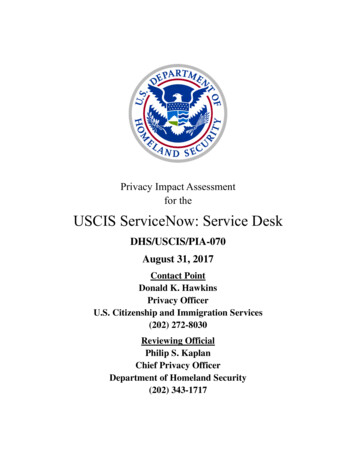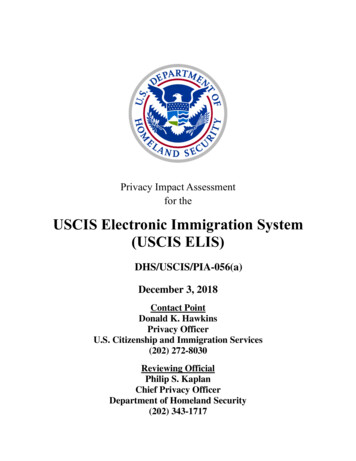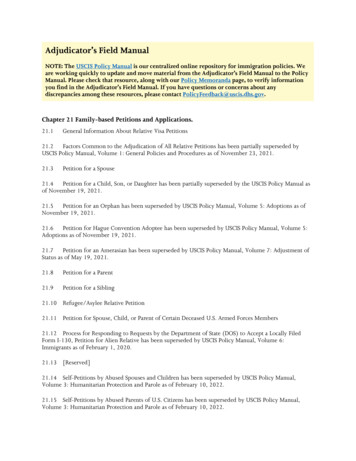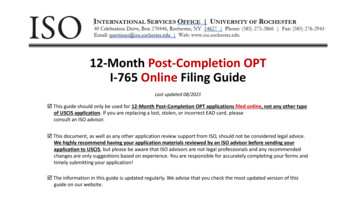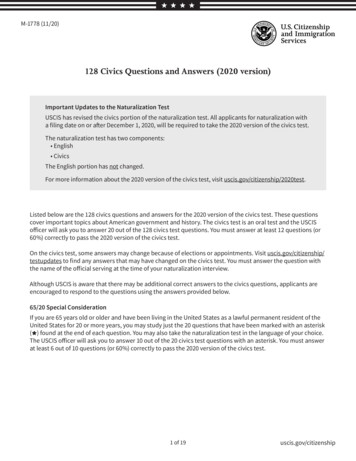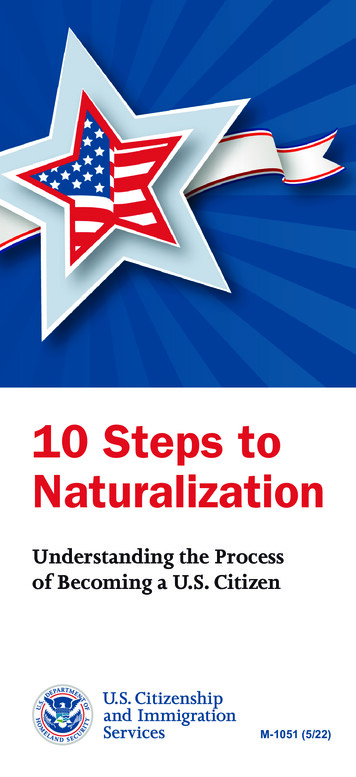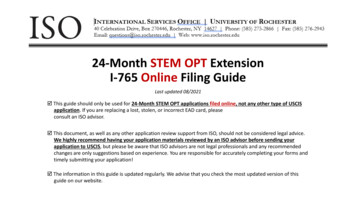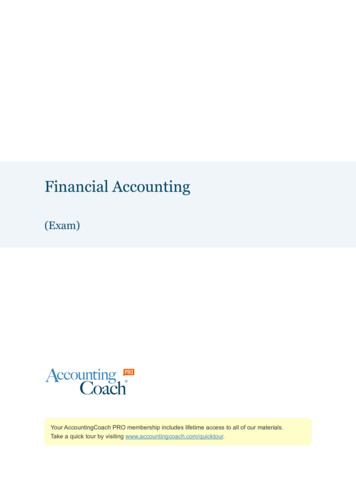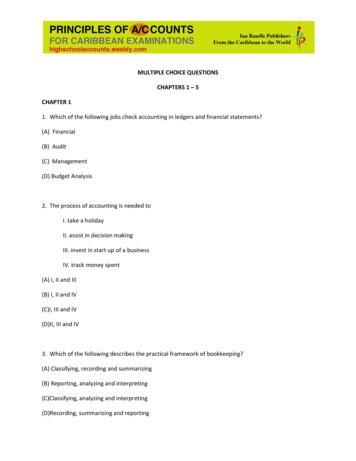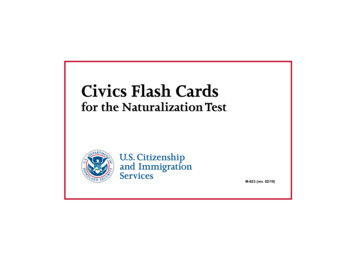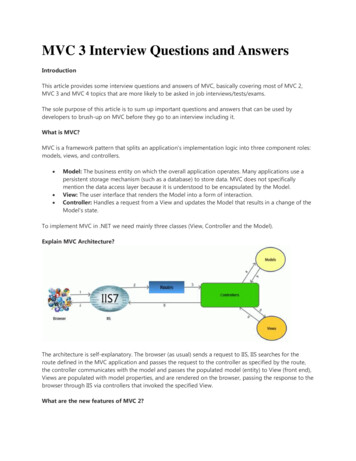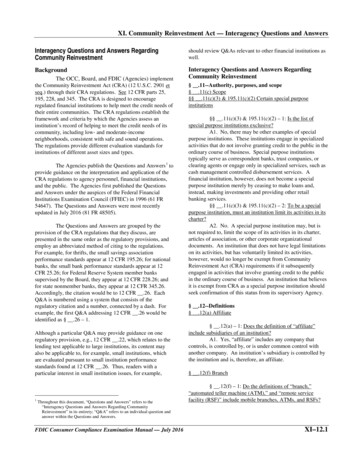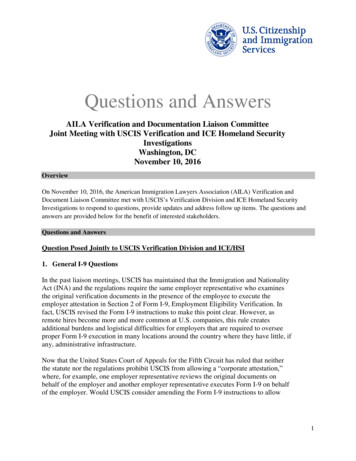
Transcription
Questions and AnswersAILA Verification and Documentation Liaison CommitteeJoint Meeting with USCIS Verification and ICE Homeland SecurityInvestigationsWashington, DCNovember 10, 2016OverviewOn November 10, 2016, the American Immigration Lawyers Association (AILA) Verification andDocument Liaison Committee met with USCIS’s Verification Division and ICE Homeland SecurityInvestigations to respond to questions, provide updates and address follow up items. The questions andanswers are provided below for the benefit of interested stakeholders.Questions and AnswersQuestion Posed Jointly to USCIS Verification Division and ICE/HSI1. General I-9 QuestionsIn the past liaison meetings, USCIS has maintained that the Immigration and NationalityAct (INA) and the regulations require the same employer representative who examinesthe original verification documents in the presence of the employee to execute theemployer attestation in Section 2 of Form I-9, Employment Eligibility Verification. Infact, USCIS revised the Form I-9 instructions to make this point clear. However, asremote hires become more and more common at U.S. companies, this rule createsadditional burdens and logistical difficulties for employers that are required to overseeproper Form I-9 execution in many locations around the country where they have little, ifany, administrative infrastructure.Now that the United States Court of Appeals for the Fifth Circuit has ruled that neitherthe statute nor the regulations prohibit USCIS from allowing a “corporate attestation,”where, for example, one employer representative reviews the original documents onbehalf of the employer and another employer representative executes Form I-9 on behalfof the employer. Would USCIS consider amending the Form I-9 instructions to allow1
greater flexibility for employers attempting to deal with the logistical challenges of FormI-9 compliance for remote hires?1While we understand the challenges for companies who hire remotely, USCIS is not reversing itspolicy on corporate attestation. The version of Form I-9 at issue in the case you reference wasdetermined by the court to be ambiguous; since then, the agency has updated its guidance thatthe same person who reviews original documentation in the physical presence of the employeemust complete the Section 2 attestation.a. If employers have a question for ICE HSI, OSC, or USCIS (E-Verify or VerificationDivision in general), please confirm that the following contact information is accurateand appropriate. If there is any other contact information that we should be aware of,please confirm. Additionally, please confirm whether email is preferred over the phone.2. USCIS Verification DivisionThe contact information below is accurate.E-Verify Customer Support is available to assist with using E-Verify, password resets,assistance with cases, technical support, E-Verify policies and procedures, Form I-9, andemployment eligibility. (M-F, 8 a.m. to 5 p.m.)For Employers:888-464-4218877-875-6028 (TTY)E-Verify@dhs.gov888-464-4218877-875-6028 (TTY)For E-Verify Employer Agents:E-VerifyEmployerAgent@dhs.govFor Employees:888-897-7781877-875-6028 (TTY)E-Verify@dhs.govE-Verify Technical Support is available to help with problems accessing and using E-Verify. (MF, 9a.m. to 8 p.m. Eastern, excluding federal holidays)For Employers and E-Verify Employer Agents:800-741-5023For myE-Verify and Self Check, the E-Verify customer call center is able to answer otherquestions about the myE-Verify and Self Check services.855-804-0296myE-Verify and Self Check Customers: 877-875-6028 ov1See Employer Solutions Staffing Group II, LLC v. The Office of the Chief AdministrativeHearing Officer, Case No. 15-60173 (5th Cir, Aug. 11, 2016).2
USCIS National Customer Service Center has a tiered structure which is publically available.2As such, we would like to know the following about ICE HSI, USCIS Verification, and OSC:a. In general, what teams or departments are responsible for handling public inquiries ateach agency? Are they government employees or contractors?USCIS, Verification Division, Customer Contact Operations (CCO) employees arefederal employees who are responsible for handling public inquires.b. Are phone calls recorded and reviewed for quality control? If so, how are calls reviewed(spot audit of recorded conversations, supervisory review of call notes made byrepresentative on the call, etc.)?Telephone calls are not recorded; however, CCO supervisors and team leads continuallytrain staff and monitor live phone conversations. This approach has resulted in CCOconsistently receiving high praise for their customer service.c. If an employer or attorney calls the general information line and is not satisfied with theinformation provided, what is the preferred method for escalating the call to a higherlevel? For example, should the caller request to speak with a supervisor, send an emailexplaining the issue and referencing the call, etc.?The caller may ask to speak to the supervisor or team leader of the CCO representativefor assistance and will be transferred to the supervisor or team lead immediately. If CCOis unable to answer the inquiry, a referral is made to the E-Verify branch for assistance.Once a response is received from E-Verify, CCO will contact the individual with theinformation.3.E-VerifyThe E-Verify Supplemental Guide for Federal Contractors (9/2010) states under 6.4SUBSIDIARIES AND AFFILIATES, “Only the legal entity (business) that signs the contract isconsidered the Federal contractor with the E-Verify clause, and is bound by the E-Verifyobligation. Whether certain subsidiaries and affiliates are a part of the legal contracting entitydepends on the specific factual context. Consult your legal counsel if you have additionalquestions about this topic.”a. What are the legal considerations when deciding which entities in a parent/sub oraffiliated entity are required to enroll its employees? What indicia of affiliation wouldmake a difference? Does it matter how the E-Verify registration has been completed?2See USCIS Policy Manual, Volume 1, Part A, Chapter 3 – National Customer ServiceCenter (NCSC), available at alVolume1-PartA-Chapter3.html.3
USCIS recognizes the possibility of too many potential scenarios for the agency toprovide sufficient guidance in this regard and leaves the determination of how to treatsubsidiaries and affiliates to companies and their own legal counsel.b. If an employer is enrolled in E-Verify and realizes that the federal employeridentification number (FEIN) currently listed in the company profile is incorrect, can theemployer go into the system and correct the FEIN, or contact E-Verify to request thecorrection? Or, must the employer ask that the account with the wrong FEIN be closedand re-enroll in E-Verify?If an employer notices that any of their company information is incorrect or requiresupdating the employer should update their Company Information Page in their E-Verifyaccount.c. AILA members report that site visits are being conducted by E-Verify related to deskaudits. When is a site visit required and how should an employer expect to be notified?Are the individuals conducting the site visits USCIS employees or contractors? Whatshould an employer expect to occur during one of these visits, and are there documentsthat need to be prepared in advance?E-Verify Monitoring &Compliance (M&C) staff who are federal employees conduct sitevisits when they believe a face-to-face meeting rather than communicating by email orphone call would be more helpful in understanding and addressing possible noncompliantactivity.M&C conducts site visits with the consent of the employer. Employers are contactedinitially on the phone by M&C to request the employer’s participation and to schedule atime for a site visit. A confirmation email will then sent to the employer once M&C andthe employer agree on the date, time and participants.A site visit is an opportunity for M&C staff and E-Verify users to meet in person todiscuss observations and recommendations in an effort to assist the employer in beingcompliant with the E-Verify Memorandum of Understanding, E-Verify Manuals, Form I9 instructions, and applicable laws.Some of the documents employers may be asked to provide include, Further ActionNotices, Referral Date Confirmations, Termination Letters or copies of documents thatare related to the particular web services application used to interface with E-Verify, ifapplicable.After a brief introduction and discussion of what to expect from the site visit, M&C willask E-Verify users about their general use of E-Verify as well as questions about specificE-Verify cases to clarify or better understand how the employer is using E-Verify. At theend of the site visit, M&C will provide a summary of observations and recommendations.Generally, site visits will last two to three hours depending on the subjects discussed andthe needs of the employer.4
d. Can you please provide an update on the proposed revisions to the E-Verify program,which would include a reverification feature?The E-Verify PRA is under review with the Office of Management and Budget. We donot have an estimated time frame for when reverification will be released.e. AILA would like to thank USCIS for addressing our questions and concerns regardingthe new process of locking user IDs and for issuing updated guidance. As a follow-up: How many user IDs have been locked since USCIS began locking E-Verify user IDsthat have been inactive for 270 days or more?Between Aug. 21 and Nov. 10, approximately 762,792 user IDs have been locked. Ofthose locked, 1,906 users have unlocked their accounts. If a user needs an ID unlocked, what is the preferred way to do that – by telephone orby email? How long on average does it take for the account to be unlocked when asecurity question hasn’t been established and the user is required to contact E-Verifyto unlock a user ID?The preferred method for unlocking user IDs is the self-service feature in E-Verify.When a user goes through the help desk to unlock an ID, this process takes about 5minutes.f. E-Verify defines a “hiring site” as “the location where employees are hired and theycomplete Form I-9.”3 E-Verify further states that a “participating hiring site means that anemployer will create an E-Verify case for every newly hired employee who is hired andcompletes a Form I-9 at that site.”4 Remote employees, however, may be hired to workfrom their homes and then travel to a third party employer agent to complete Form I-9.The same company may use a number of agents in different states. Please advise how theconcept of “hiring site” applies to remote employees. Do the employees’ homes need tobe listed in E-Verify as hiring sites?When an employee is hired remotely and visits a third party employer agent to completeForm I-9, for E-Verify purposes, the “hiring site” is the location of the third partyemployer agent where the Form I-9 was completed, not the home of the employee.g. 28 CFR 68.52(c)(6) states that “failure to notify the Attorney General” that an employeecontinues to work after receiving a final non-confirmation in E-Verify is a violation that3E-Verify User Manual, Aug IS/Verification/E-Verify/EVerify Native Documents/EVerify%20Manuals%20and%20Guides/EVerify User Manual Employer.pdf, pp. 69-70.4Id.5
will result in a civil penalty. Is updating the E-Verify system, per the E-Verify usermanual, considered sufficient notice per 28 CFR 68.52(c)(6)?Closing the case in E-Verify with the statement “The employee continues to work for theemployer after receiving a Final Nonconfirmation” in the system is sufficient notice.h. Employers who do business in many states are often confused about the various staterequirements for E-Verify. There does not appear to be one accurate source ofinformation to obtain each state’s E-Verify requirements. There are a few commercialwebsites that provide updated information, but there is also a lot of outdated informationthat appears in a Google search (including old USCIS E-Verify PowerPointpresentations). Is there a source that USCIS uses to obtain this information or to refer thepublic? If so, can you post it on the E-Verify website?USCIS does not comment on state laws which have no bearing on E-Verify requirements.Employers that are required to participate in E-Verify due to state laws may contact theapplicable state for more information.i. There is confusion regarding science, technology, engineering and mathematics optionalpractical training (STEM OPT) and E-Verify with what appears to be conflicting agencyguidance. USCIS has stated previously that the company location where the STEM OPTemployee will work must be enrolled in E-Verify. What is the statutory authority for the requirement that a specific company locationmust be enrolled in E-Verify? The new STEM OPT final rule, published on March11, 2016 (81 FR 48) only requires company enrollment but does not address thespecific worksite. In addition, a review of the guidance on the DHS STEM OPT Hub(https://studyinthestates.dhs.gov/stem-opt-hub) also only refers to the companyenrollment.The final rule requires all employers training STEM OPT students to participate in EVerify, as required since 2008. To participate in E-Verify an employer must enroll thehiring site or location where the F-1 STEM OPT employee will work and create a casein E-Verify for all new hires, including all F-1 STEM OPT employees, at that hiringsite. See 214.2(f)(10)(ii)(c)(5) We have seen the terms “hiring site” and “worksite” used regarding E-Verify andSTEM OPT. Hiring sites can be different than worksites. To clarify, is therequirement that the hiring site or the worksite must be enrolled?A STEM student may change employers, or work at a different hiring site for the sameemployer but the new employer or new hiring site must be enrolled and in goodstanding in E-Verify before the student begins work for pay.j. We are interested in learning more about the E-Verify TEAM program. When did thisinitiative begin? What are the advantages of the program? How does an employer enroll?6
Are all E-Verify participants eligible? How many strategic response managers (SRMs)are there?T.E.A.M. was an older term used by E-Verify to describe the first strategic relationshipmanagers (SRMs). In 2011 E-Verify began assigning SRMs to employers who neededextra help with ensuring that those users were using E-Verify correctly and efficiently.There is no enrollment process to establish an SRM relationship. Any E-Verify employercan be referred by other Verification branches such as M&C. E-Verify currently has 9SRMs.4. Form I-9 CompletionThe instructions to Form I-9 state “Providing your Social Security number is voluntary.However, if your employer participates in E-Verify, you must provide your Social SecurityNumber.” We have always understood this to mean that if the employer is enrolled in E-Verifyin a way that requires a particular employee to be run through E-Verify, the employee needs tolist his Social Security number (SSN) on Form I-9. It is not a blanket requirement for allemployees of an employer who, for example, may only be enrolled in a single state or pursuantto a single government contract. Please confirm that this is correct.A Social Security number (SSN) is required to create a case in E-Verify. When completing FormI-9, employees must provide their SSNs if their employer is enrolled in E-Verify. Employerswho enroll only one hiring site in E-Verify must require all new employees hired at that site toprovide their SSNs on their Form I-9; SSNs are not required on Form I-9 of new hires at sitesthat are not enrolled in E-Verify. Employers who are awarded a federal contract with the FederalAcquisition Regulation (FAR) E-Verify clause require SSNs on the Form I-9 of employees whoare new hires or existing employees assigned to the FAR contract. Note: If an employer has onlyone hiring site, then all of its new hires and employees assigned to the FAR contract mustprovide their SSNs on their Form I-9.The regulations state that a student with optional practical training must obtain an EmploymentAuthorization Document (EAD) in order to work.5 If a student applies for and receives the EAD,may the student nonetheless present the Form I-20, passport, and Form I-94 (which combine tomake a List A document) to prove work authorization, or must the employer require the EAD?F-1 nonimmigrant students participating in optional practical training must present an EAD. TheF-1 student must obtain an EAD from USCIS before he or she is authorized to work and may notbegin employment until the date indicated on the EAD. The employer must record the EAD cardnumber and expiration date under List A in Section 2. If the student’s EAD expires, the employermust reverify the student’s employment authorization in Section 3.Only F-1 nonimmigrant students participating in curricular practical training may present thethree documents (the Form I-20, passport and Form I-94) to establish identity and employmentauthorization.5See 8 CFR §214.2(f)(10)(ii)(A).7
When border commuters from Canada or Mexico list their address in Section 1 of Form I-9,where, if anywhere, should they list the country of residence? There is no specific field for“country.”Border commuters from Canada or Mexico may use the city or town block to enter their addresssuch as, Toronto, Ontario, CAN. The revised Form I-9 that will be published by Nov. 22 allowsborder commuters to enter their city and province or state in one field and includes the country inthe drop-down for the state field, either CAN or MEX.5.Confidential informationForm I-9 files will contain “Personally Identifiable Information (PII).” There is a legal obligationto protect such information. In the I-9 Central Questions and Answers, in response to thequestion “How Can I Protect Private Information on Forms I-9,” USCIS advises that Form I-9information is private “and that it is used only for Form I-9 purposes.”6 Is USCIS consideringissuing a policy statement to identify under what circumstances Form I-9 information istransferrable to other parties when dealing with contractors and subcontractors, mergers andacquisitions, enforcement agencies, and state and local governments?Under federal law, use of Form I-9 and any information contained in or appended to the form islimited to enforcement of the Immigration and Nationality Act, as amended, and 18 U.S.C. 1001,1028, 1546, and 1621. Information about which agencies may request to inspect Form I-9 maybe found at m-i-9/inspection/inspections.Federal privacy laws only apply to disclosure of information by the federal government, and notby private entities. Whenever an employer deals with documents containing personal informationof individuals, adequate safeguards should be taken to ensure the information is notcompromised.6. Electronic SignaturesThe regulations relating to electronic Form I-9 state that there must be “no change to the name,content, or sequence of the data elements and instructions” and that “no additional data elementsor language” may be “inserted.”7 Please confirm that this refers to the printable Form I-9generated by the electronic software and not to the interface itself with the new hire and/oremployer representative. For example, USCIS’ proposed form includes pop-ups to assist withcompletion of Form I-9, and the vast majority of available electronic Form I-9 software includesan interface with language in addition to that on Form I-9 itself. Further, additional language isseemingly necessary to comply with the electronic signature requirements. As such, it seemsthat, so long as the full form and instructions are available to the employee, the regulatoryrequirement relates to the printable form generated by the 8 CFR 274a.2(a)(2).8
The revised Form I-9 includes only the data elements and instructions necessary to complete theform. It does not, for example, include a data element or language related to whether or not anindividual served in the military. The regulations provide that the electronic Form I-9 mustreplicate the paper Form I-9 process. For that reason, USCIS provided all of the helper text toemployers in the instructions in the paper form. Whether completed on a computer and thenprinted out or printed out first and then completed by hand, employees and employers haveidentical experiences and the result is an identical Form I-9.The regulations relating to Section 1 electronic Form I-9 signatures state: “The system used tocapture the electronic signature must include a method to acknowledge that the attestation to besigned has been read by the signatory.”8 On the paper Form I-9, there is no method to confirmthat the employee has read the attestation statement, other than the fact that the attestationstatement is located in the signature block.a. Please confirm that displaying the language on the screen on which the signature isexecuted satisfies the requirement or, if not, please explain what is required.All electronic forms must include a method to allow the employee to confirm that he orshe has read the attestation statement before signing the form and displaying the languageon the screen on which the signature is executed does not satisfy the requirement. Theemployee must affirmatively acknowledge that he or she has read the attestation. Thisrequirement does not apply to forms that are completed on paper.b. On a related note, the regulations relating to Section 2 electronic signatures state: “Thesystem used to capture the electronic signature should include a method to acknowledgethat the attestation to be signed has been read by the signatory.”9 Does the use of theword “should” (as opposed to “must” which is used in the Section 1 portion of theregulations) indicate a different obligation in Section 2 than applies in Section 1?Yes, there is a different obligation in the Section 2 attestation than there is in the Section1 attestation.7. Agency-Specific Questions:Questions for USCISThe I-9 Central Questions and Answers section contains critical interpretations of the law.The questions are organized into general categories, and each answer must be “expanded” toshow the answer. This makes it difficult for an employer or counsel to review and study theentire corpus of questions and answers or to download the questions and answers for futurereview and study. Can the service insert an “expand all” option to make the information morereadily accessible?88 CFR 274a.2(h)(1).98 CFR 274a.2(h)(2)(i).9
Yes, this is something we will do; it requires some developing and we are currently workingon providing a way for the public to expand all questions and answers on I-9 Central so thatall information is displayed at one time.USCIS announced in the Aug./Sept. 2016 E-Verify Connection newsletter that the new FormI-9 will be released by 11/22/2016. In the event that the new version of Form I-9 is notreleased before this meeting, we would appreciate any updates you can provide relating tothe timeline for the release and features of the form. Specifically, will this be a “Smart”fillable PDF as proposed in the related Federal Register notices last year, or has USCIStabled the “Smart” features and USCIS plans to instead release a paper version in basic PDFformat and which, like the current PDF version available, lacks interactive fillable features?USCIS will release a new Form I-9 by Nov. 22 of this year. The new Form I-9 that will bereleased includes the features the public was asked to comment on in the Federal RegisterNotice last year.10
For myE-Verify and Self Check, the E-Verify customer call center is able to answer other questions about the myE-Verify and Self Check services. myE-Verify and Self Check Customers: 855-804-0296 877-875-6028 (TTY) Email: myEVerify@dhs.gov EVerifySelfCheck@dhs.gov 1 See Employer Solutions Staffing Group II, LLC v. The Office of the Chief .
